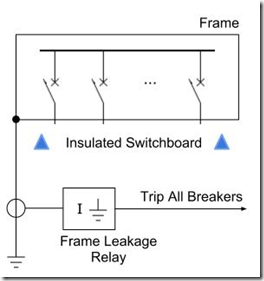Frame Leakage Protection

Frame Leakage Protection Principle While not as popular as it once was, frame leakage protection does still have some use in some circumstances. In essence frame leakage is an earth fault type protection. A current transformer installed in a connection from the frame to earth monitors any fault current and operates an instantaneous relay.
The fault measuring connection is the only link to earth. All other connections, including the frame of any switchgear or controlgear assemblies are insulated from earth.
The main reason for using frame leakage to its ability to detect low levels of fault current. An example would be a d.c. rail traction system, where the return rail is insulated (in addition to the switchgear) and by the use of frame leakage protection it is possible to detect high impedance faults away from the switchgear.
In practice it is invariably difficult to fully insulate any item of equipment from earth. Resistance values of 10 ohms or so would be typical.
Tip: while insulating the entire switchgear frame, care must also be taken to use insulating cable glands and in ensuring that no inadvertent earth connections are made.
With the inclusion of transformer neutral earthing, generators, double and sectioned bus bars implementation of frame leakage becomes more complex. Modern numerical relays are cost effective and provide a large number of features, making them an attractive alternative to the implementation of frame leakage.